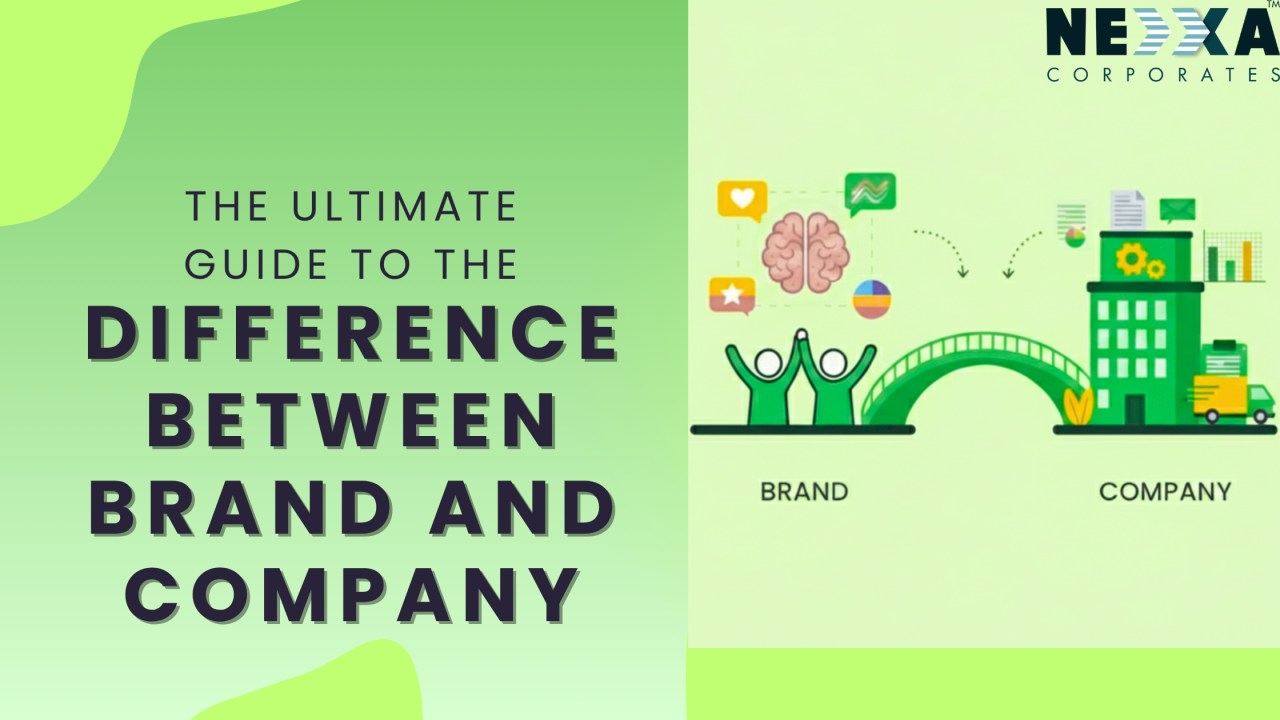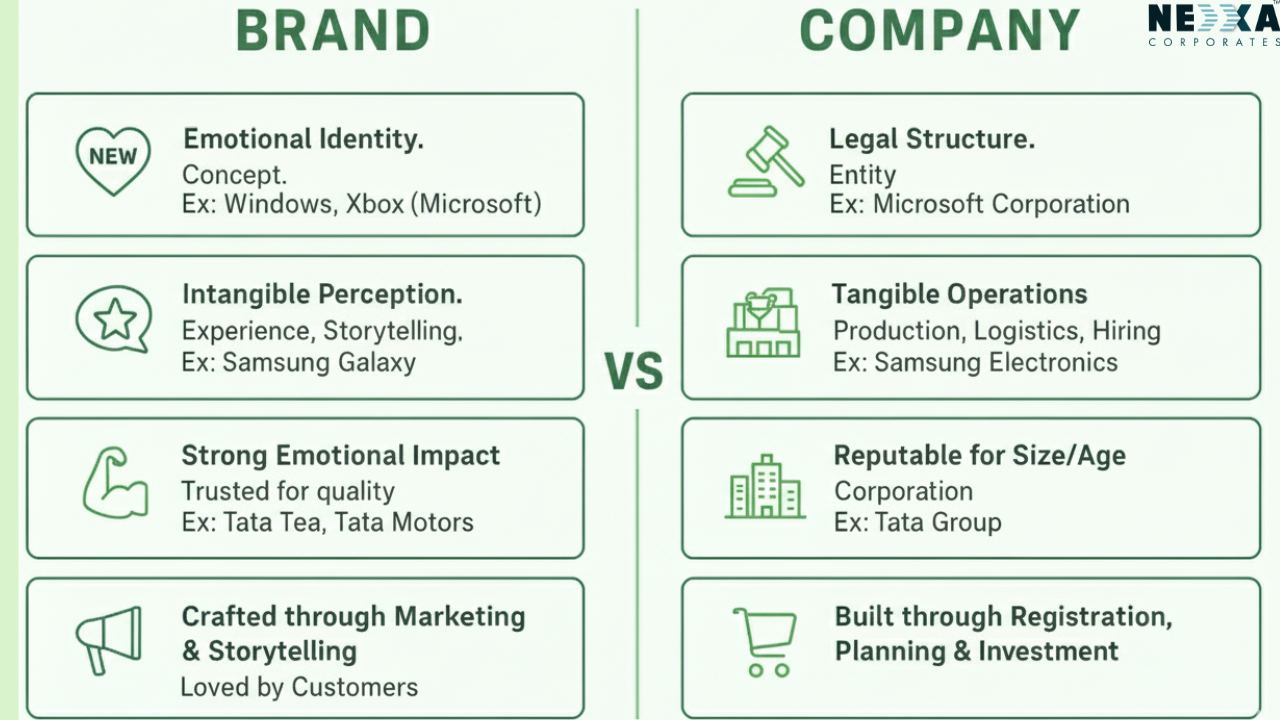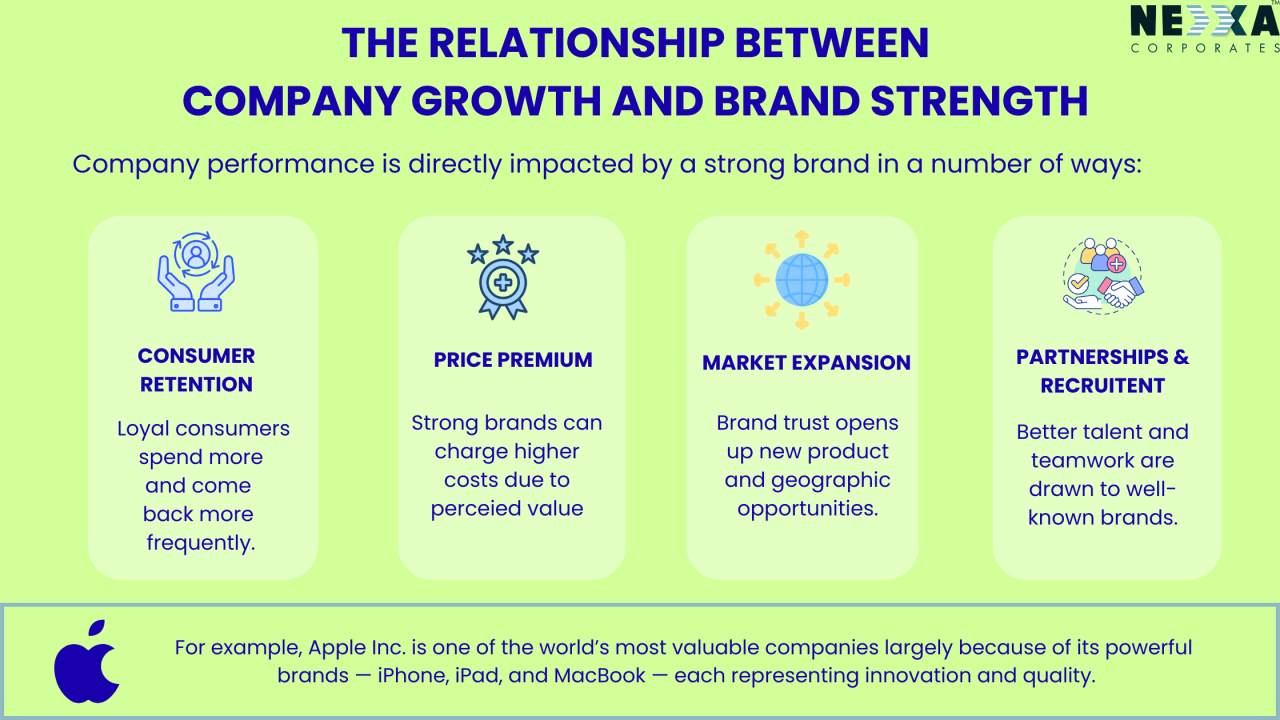Table of Contents
Ultimate Guide to the Difference Between Brand and Company

These days, it is common to hear people saying “this brand launched a new company” or “our company brand.” The terms “brand” and “company” are used interchangeably. They stand for two separate yet related concepts in the fields of marketing and business.
Learning the difference between brand and company is not just about the correct terms — it defines your entire brand marketing strategy. It includes knowing how companies work, interact, and develop. This difference helps business owners, startups, and marketing specialists in certain ways:
1.Design a targeted brand marketing plan.
2.Strengthen connections with customers.
3.Expand company in a sustainable and efficient manner.
The market is very competitive. People don’t just purchase from companies. They like to buy from reputable brands that they trust.Hence even a legally strong company might fail if its brand cannot connect with its audience emotionally.
Read on to learn the difference between brand and company, understand brand vs company perspectives, and see how this knowledge helps to develop a lasting corporate identity.
What is a Company?
A company is the legal and operational backbone of a business. It is an entity formed to produce goods or deliver services with the goal of making a profit. In legal terms, it is recognized by government authorities, pays taxes, hires employees, and manages operations.
A company can be considered as the engine that powers the business. It takes care of production, logistics, finances, and strategy.To ensure long-term growth and identity, collaborating with a trusted branding company in Kerala can help align your company’s vision with a powerful market presence.
Key Features of a Company
1.Legal Registration:
A firm must be registered under corporate laws in order to conduct business lawfully. It may be a company, LLC, partnership, or sole proprietorship.
2.Ownership and Management:
Companies have defined ownership structures — such as shareholders, founders, or partners — and decision-makers like CEOs or directors.
3.Operations and Revenue:
A company manages everything from manufacturing to sales and distribution to ensure consistent growth and profit.
4.Accountability and Regulation:
A company follow rules, file taxes, and meet compliance standards to maintain credibility and sustainability.
Please see below the examples for Companies
1.The Coca-Cola:
A multinational beverage producer that owns a variety of brands such as Sprite, Fanta and Coca-Cola. The business is in charge of distribution, marketing, and production.
2.Unilever:
An international corporation that handles over 400 brands, including Lipton, Knorr, Dove, and Surf Excel. Despite having different positioning, all brands use the same corporate infrastructure.
In simple terms, a company is the structure that enables products and services to exist — a key point in understanding the difference between brand and company.
What is a Brand?
When a company deals with the business side of things, a brand handles the emotional and psychological side. A brand is the identity, image, and reputation of a product or company in the eyes of consumers — clearly highlighting the difference between brand and company.
Essential elements of a Brand
1.Brand Identity
Brand identity is composed of the visual and technical components like name, logo, tagline, color scheme, typography, and packaging ,all that establish your brand’s identity.
2.Brand Personality
It is defined by the human qualities that your brand stands for, such as being social like Coca-Cola, smart like Chanel, or adventurous like Red Bull.
3.Brand Promise
The expectation you set for customers — for example, Volvo promises safety, while FedEx promises reliability.
4.Customer Experience
Every connection counts.Brand perception is affected by packaging, customer service, social media tone, website design, and even after-sale assistance.
Examples of Brands
1.Apple Inc. (Company) vs iPhone (Brand) :
The iPhone is designed and marketed by Apple Inc. Innovation, superior craftsmanship, and a contemporary lifestyle are all embodied by the “iPhone” brand.
2.Nike Inc. (Company)vs Nike (Brand) :
Nike’s brand symbolises motivation and athletic excellence. The swoosh and “Just Do It” slogan are powerful emotional appeals that connect deeply with worldwide audience.
A brand takes time to develop. It is built through consistent messaging, design, and experiences — all part of an effective brand marketing strategy that makes customers trust you.
Brand vs Company: Understanding the Difference
While both terms are often used together, the brand vs company distinction shows their roles in business are very different. A company is tangible ; you can register it, invest in it, or visit its office. A brand, however, is intangible ;it lives in the hearts and minds of your audience.

Key Difference Between Brand and Company
1.Legal Structure vs Emotional Identity
A brand is an emotional concept whereas a company is a legal entity.
For example Microsoft Corporation is the company, but Windows and Xbox are brands that evoke innovation and reliability in consumers’ minds.
2.Tangible Operations vs Intangible Perceptions
Customer experience, storytelling and design are what make a brand while a company handles physical tasks of production, hiring and logistics.
The Samsung Electronics Co. Ltd., for example, is a business, but for the consumers ,it is the Samsung Galaxy brand which is often associated with innovative technology and modern design.
3.Reputed Company vs Strong Brand
A brand can be strong for its emotional impact whereas a company can be reputable for its size or age.
For Example: Tata Group is known as a highly reputed corporation whereas Tata Motors and Tata Tea are brands trusted by millions for quality and heritage.
4.Creation Process
Brands are crafted through marketing, experience, and storytelling while companies are built through registration, planning, and investment.
5.Relationship with customers
The customers might buy products from companies but they love the brand — that emotional connection is what defines the difference between brand and company.
Why Both Matter Together
A company’s structure and the brand soul are both essential for a business to succeed — they represent two sides of the brand vs company relationship.
A brand adds personality, significance, and market distinction whereas a company offers infrastructure, financial support, and legal recognition.
For example, consider the case of P&G (Procter & Gamble) , the corporation that owns many popular brands, including Pampers, Gillette, and Ariel. Although each brand has its own target market and promise, they all benefit from the parent company’s operational strength. Without strong branding, P&G’s portfolio would not emotionally connect with consumers — showing how a smart brand marketing strategy drives success. Without strong branding ,P&G’s portfolio would not emotionally connect with consumers. Basically, businesses give value, but brands win consumers.
How to Build a Strong Brand Marketing Strategy
The relationship between what your company does and how others perceive it defines your brand marketing strategy, reinforcing the difference between brand and company in action. It’s not about just selling ,it’s about building meaning and memory in the consumer’s mind.
1.Define Your Brand Positioning
Identify what makes your brand different. Are you tech-driven, costly, economical, or ecologically conscious? How people compare you to your competition is determined by your placement.
2.Create an Engaging Brand Narrative
Storytelling humanizes business. Share your origin, mission, and purpose. A strong story turns a product into an experience just like TOMS, which links every shoe sale to social impact.
3.Be Consistent
Every interaction through website, advertisements, social media, and packaging should convey the personality of the brand. Consistency creates trust and the recognition.
4.Put Experience First
From customer care to post-purchase assistance, create unforgettable experiences that strengthen your brand marketing strategy and customer loyalty. Starbucks, for instance, offers more than simply coffee—each cup offers a warm, unique moment.Focusing on customer experience helps you build loyalty and trust, transforming ordinary transactions into emotional connections that drive retention and advocacy.
5.Employ Emotional Marketing
Emotions, not reason, influence the decisions that the consumers make. Use design, brand storytelling, and customer interaction to create a good brand image.
6.Change with Your Consumers
Brands are living entities. As consumer behavior changes, adapt your identity and messaging. A great reference is how Instagram evolved from a photo app to a lifestyle and business platform.
The Relationship Between Company Growth and Brand Strength

Company performance is directly impacted by a strong brand in a number of ways:
1.Retention of consumers: Loyal consumers spend more and come back more frequently.
2.Price Premium: Due to perceived value, strong brands are able to charge higher costs.
3.Expanding the Market: Brand trust opens up new product and geographic opportunities.
4.Partnerships and Recruitment: Better talent and teamwork are drawn to well-known brands.
To strengthen these aspects and reach your audience effectively, businesses should invest in digital marketing as part of their overall brand strategy. It helps amplify brand awareness, nurture customer loyalty, and convert visibility into sustainable growth.
For example, Apple Inc. is one of the world’s most valuable companies largely because of its powerful brands — iPhone, iPad, and MacBook — each representing innovation and quality.
Conclusion
A brand is different from a firm in the same way that a person’s physique is different from his personality — the perfect example of the difference between brand and company. A company is the structure, that makes, manages, and delivers.
A brand is the spirit, it inspires, influences, and connects.
Without branding, a business can exist, but it won’t expand in a sustainable way. A brand can’t exist without a company backing it operationally. The magic happens when both align — when the company’s mission and the brand’s message work in harmony.
FAQ
1. Is every company a brand?
No. A company is a legal and an operational entity, while a brand is a customer’s perception. A company becomes a brand only when it builds a recognition and emotional connection with the customers.
2.Can a company own multiple brands?
Yes. For instance, Unilever owns several brands like Dove, Lifebuoy, and Knorr , each targeting different markets and audiences.
3. Why is the brand identity more than just a company name?
People relate a brand with its images, values, and experiences. Starbucks’ brand value is defined not only by its name ,but by its logo, atmosphere, and individualized service.
4. Can a brand exist without a company?
No. Every brand requires a business for production, management, and funding. A company’s efforts are reflected in its brand.
5. What happens if a company has a weak brand?
Even if a company has good products, bad branding makes it unimportant. Consumers want brands that represent trust and innovation, such as the Nike or Samsung.
6. How can a brand marketing strategy help business?
Branding turns one-time clients into loyal ones, boosts popularity, and builds trust and loyalty.
7. Which is more important — the company or the brand?
Both are necessary. While the brand fosters emotional attachment, the firm establishes the framework and provides the goods. They create a sustainable business ecosystem when combined.
